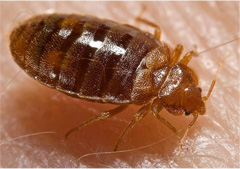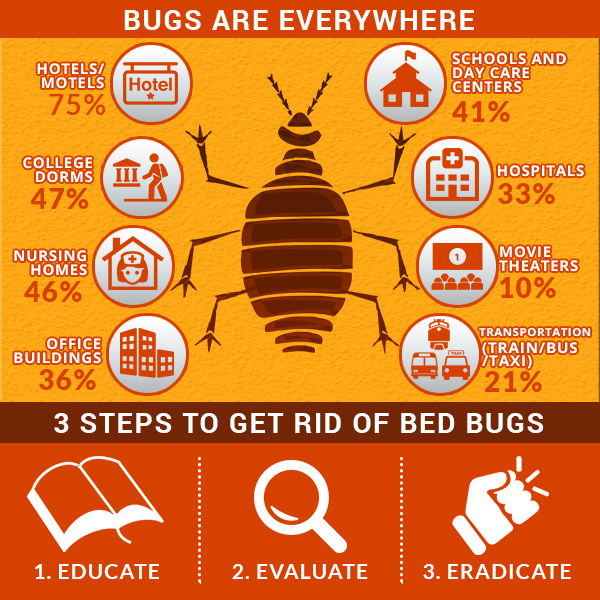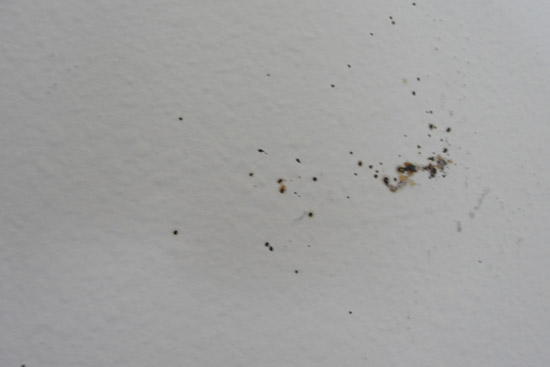 This page explains in detail the full process of getting rid of bed bugs. Before you get started though, you need to ask yourself if you’re equipped and prepared for the task. Read here to find out if you need an exterminator or not.
This page explains in detail the full process of getting rid of bed bugs. Before you get started though, you need to ask yourself if you’re equipped and prepared for the task. Read here to find out if you need an exterminator or not.
How to Get Rid of Bed Bugs
This section breaks down getting rid of bed bugs into four parts. First, you will need to pretreat your apartment.
This involves finding the bed bugs, isolating them, and preparing the rooms and furniture for the use of pesticides and heat. The second phase is the extermination of the bed bugs through various methods.
The third phase details how to check whether you are actually bed bug free, and how to prevent a future infestation. Finally, we have included a list of things you must be sure not to do when dealing with an infestation.

Pre-treatment
When you want to get rid of bed bugs, the first phase of exterminating a bed bug infestation is pretreatment.
This begins with a general cleaning of your house including tidying and vacuuming, throwing out of items that are beyond saving, and finding all of the areas where bed bugs are hiding.
If you live in an apartment, before anything else, notify your landlord and neighbors.
Start the pretreatment with a widespread extremely thorough cleaning of the residence:
- Tidy your home: Put all of the items you think may have been affected in one place away from everything else. Clear any clutter from around your bed and couches.
- Clean house: Clean all of your bedding and sheets, mattress covers, couch covers, linens, and curtains. Clothing and bed linen is generally not safe to treat with pesticide.
- Wash everything with extreme heat: literally wash everything on your washing machine’s highest heat setting and then run it through your dryer on the hottest setting (at least 140 degrees) for a minimum of thirty minutes.
- Items that cannot be washed (shoes, stuffed animals, coats, etc.) should be run through the dryer on its highest heat setting for at least half an hour.
- Once you have washed and dried everything, place it all together and wrap it securely in thick plastic bags (preferably thick trash bags) and isolate it. Place it either, outside in the sun where it will continue to be exposed to high temperature, or in a place where the infestation has not reached (e.g. a garage or storage) until the treatment is finished. You can place a ‘Nuvan ProStrip,’ which can be bought online inside these bags to kill any remaining bed bugs. Check all items thoroughly for bed bugs before returning them.
- Time to Vacuum Once: you have done all of the above, thoroughly vacuum your home.
- Use a stiff brush to remove any bed bugs or eggs you have identified from walls, mattress seams, and carpets. Flip over your furniture and carpeting to inspect underneath them as well.
- Vacuum your bed, couches, carpets and the surrounding area thoroughly. Vacuum near furniture and along baseboards as well. Use a vacuum attachment and scrape the areas you are vacuuming as bed bugs can hold on tightly. Do so frequently. As soon as you have finished vacuuming, remove the vacuum bag, seal it in a plastic bag, and place it in a trashcan outdoors far from your house.
The Next Steps:
Once you have finished the initial cleaning, you will need to inspect every nook and cranny of your residence and identify where the infestation is, so you will know where to focus your treatment.
It may be helpful to read our page on identifying an infestation first. Keep note of any bed bugs or signs of bed bugs from your general cleaning and begin your inspection:
- Pull all of your furniture away from the walls to allow you to inspect the walls and the furniture more thoroughly.
- Inspect your furniture. Remove cushions from couches and chairs; Turn them over and inspect underneath them as well; Remove drawers from desks; Place everything that has signs of bed bugs in the same area.
- Check your mattress. The mattress is generally the focal point of a bed bug infestation, and an explanation of what to do with your mattress is in the treatment section of this page. When inspecting for bed bugs in your mattress, look at the top, bottom, and sides, as well as in the mattress seams. If there are rips in the fabric of the mattress, check in those as well. Holding a strong light against a box spring mattress can help to see bed bugs inside of the mattress. In addition, check for fecal spots and red stains from crushed bed bugs.
- Check carpeting, wood paneling, pictures frames, and the insides of closets. Check behind cracks in the wall or peeling wallpaper, inside lamps, and in any furniture or appliances bed bugs could possibly get into. Keep in mind that without feeding the bugs are extremely flat and can get into spaces as small as behind outlet covers and even in smoke detectors. Check in electrical appliances and all small hiding places.
- Dismantle your bed frame and check for bed bugs in the wood, the paneling, the foot and head boards, side railings, and all of the connections between parts.
- Check in cracks in the wall, areas where pipes or wires run through the wall, and behind peeling wallpaper. After you have treated these areas (following section), make sure to seal the area with plaster or reapply the wallpaper so that bed bugs cannot get into or out of the walls.
- There are many products you can buy to detect an infestation to better help you identify affected areas. Some examples are the ‘Catchmaster BDS’ or ‘Verifi Bed Bug Detector.’ These products will not eliminate an infestation, they will simply help you identify and monitor it.
- Look in dark and isolated areas. Thoroughly check adjoining rooms to the room where you suspect the infestation. Infestations generally start at the bed, but often branch out from there.
- Bed Bugs can be difficult to see, especially young ones or eggs. It may be useful to use a high power flashlight, a magnifying glass, and a small hand-held mirror.
- Spraying an aerosol such as V-One (or any aerosol that has Pyrethrin as an active ingredient) will flush bed bugs out of their hiding spots and allow you to identify if they are there. The aerosol will kill the bugs as well. A blow dryer on its hottest setting will accomplish the same thing.
Treatment
Now that you have identified an infestation, cleaned your house, and identified sensitive areas, you are ready to begin treatment. There are dozens of different options for getting rid of a bed bug infestation and we will cover several of them. What we recommend for anybody trying to solve this problem is what is known as an ‘Integrated Pest Management’ (IPM) solution.
An IPM solution combines multiple techniques including pesticides, natural solutions (heat), sanitation, and prevention and emphasizes using harmful products only up to an environmentally justifiable level. Before starting any of these treatments, make sure you have completed all the steps in the pretreatment section.
Otherwise, the treatment is far less likely to be successful. The use of several of the suggested methods in conjunction will give the best results. You should treat your residence at least three times, allowing for a week to two weeks between each treatment.
However, if simple to advanced DIY does not solve the cause, consider the high-end professional heat treatment, suggests the Australian Fantastic pest controller Alexander Crawley. The A-grade procedure seals of your entire room, heating it to levels bed bugs can’t survive. Temperatures required are 45°C / 113°F for adults and nymphs, 48°C / 118°F for eggs to parish, 50°C / 122°F for the rest, and 56°C / 133°F for most of the other pests, such as moths, fleas, and etc. It’s a crazy-efficient solution.
Identified Bed Bug Infestations

The following methods can be used to eliminate bed bugs in areas in which you have identified bugs and / or congregations of bugs.
Steam heat is an excellent method for getting rid of the bugs in almost any part of the house. You can find a dry steamer at most local hardware stores.
If you cannot find one or do not want to spend the money, then you can attach a plastic tube to the end of an electric kettle.
You can substitute this with a blow dryer, but they are not as effective and may only serve to scatter the bugs.
A good dry steamer will reach two hundred degrees Fahrenheit and may be your most powerful tool in dealing with an infestation.
Insecticides designed specifically for bed bug infestations are a crucial tool if you are seriously considering getting rid of bed bugs on your own.
These insecticides are split into ‘sprays’ and ‘dusts.’ These treatments should be applied several times, about a week apart each time.
During this time you will need to stay in other rooms or, preferably, in another residence. Bed bugs come out to feed every few weeks so multiple treatments are a must.
Sprays should be applied in every place you have identified or suspect an infestation. In addition, spray around and under the bed and bed frame, on the interior panels of cabinets, drawers, closets (remove all clothing an other items first), doorframes, windows, and furniture.
Make sure to read the instructions on the label before use to see where the spray can and cannot be used.
Some good sprays are Cyzmic CS (cannot be used on mattresses), Temprol SC, Alpine PT Aerosol, and Bedlam Insecticide Aerosol, and Phantom Aerosol.
Dusts are applied using a duster or a puffer. Do not apply dusts on top of sprays, but use them as a supplement in harder to reach areas or areas where liquids should not be used.
Remove electrical outlet covers and light switch covers and dust in the openings. Use dust in electrical appliances, lamps, in desks, and in bed frames.
Make sure to read the instructions on the label before use to see where the spray can and cannot be used. One of the best insecticide grade dusts is Cimexa Dust.
Rubbing alcohol sprayed on bed bugs will kill them on the spot. Buy a spray bottle and rubbing alcohol at any local convenience store. In addition, dipping a brush in rubbing alcohol and brushing over visible eggs will kill the eggs.
Diatomaceous Earth (DE) is a naturally occurring rock that is easily crumbled into a white powder.
When bed bugs come in contact with this powder, it dehydrates them and kills them over the course of a few days.
The powder remains effective as long as it remains on your floor and is useful to use at the end of a treatment as it can help prevent a re-infestation.
Because of this, DE does not require reapplication. DE (and all other dusts) can be distributed using a special ‘puffer’ which can be found online.
Breathing in DE is dangerous and can cause a respiratory disease called silicosis and you should wear a breathing mask while applying. Despite this, DE is a relatively safe solution, especially if you get ‘food-grade’ DE. Ground up Silica Gel achieves the same effect.
Gentrol IGR (Insect Growth Regulator) is a spray that prevents young bed bugs from maturing into adults and, thus, prevents them from reproducing. This is useful for long-term control and prevention of re-infestation.
Climb Up Insect Interceptors kill bed bugs that are trying to climb onto your bed. There are products you can buy online or you can make one yourself by filling bowls with soapy water and placing your bedposts in the bowl. Bed bugs will attempt to climb up to your bed and will slip in the bowl and drown.
Clean up any dead bed bugs, eggs, molding, fecal spots, or bloodstains with water and soap.
The Mattress

Mattresses are a key area of infestation and where people are generally bitten, so the topic deserves some notes of its own.
Once you have identified an infestation in your mattress (small dark fecal spots, blood stains, eggs, holes in the mattress or paneling of the bed, bed bugs) you can either treat the mattress, encase it in a special cover, or throw the mattress out.
Encasing your mattress: Covering your mattress and pillows with specially designed mattress covers is an excellent method for dealing with your bed.
These covers make sure bed bugs can not get into your bed or pillows, and that any that are inside already cannot get out and get to you.
A cover placed over an infested mattress must be left on for at least a year as bed bugs can survive up to a year without feeding.
Once you have covered your mattress with such a cover, there is no need to treat it using pesticides or any form of spray. Another benefit of these covers is, once they are on, they also prevent any future infestation.
Make sure the cover specifies it can be used for bed bugs. Hypoallergenic covers help treat against dust mites as well. Though these covers can be moderately expensive, they are the most effective solution.
Treating your mattress: Treating your bedroom with pesticides can be harmful, so make sure to follow the instructions on any label carefully and to make sure they specifically say they are safe for use on mattresses and bedding.
There are insecticides created specially for beds such as Temprid SC, Bedlam Aerosol, Steri-Fab, and many others that can be found online. To treat a mattress, first brush along the entire mattress and all the seams with a stiff brush.
After this, vacuum all over the mattress. Once you have done this, treat with the insecticide according to the instructions on the label.
Insecticides for mattresses are split into dusts and sprays. Dusts work for a longer period of time, but sprays are easier to apply to hard to reach areas.
Both can be used for better results. These can additionally be used on most other furniture.
Throwing your mattress out: Throwing your mattress out and replacing it is the final way to deal with the ‘mattress issue’.
We recommend doing so only if your mattress is truly in a bad shape. If the mattress has lots of holes and tears in the fabric and / or is covered with bed bugs, eggs, fecal spots, blood stains, and other such unsightly side effects, then getting rid of it may be more useful than the headache of treating the mattress.
It is important to note, however, that any new mattress you bring has the possibility to become infested so it may be a good idea to treat or encase the new one as well.
The Walls

Get bed bugs out of cracks in the wall or from behind loose wallpaper with a flat knife, a playing card, or using hot air from a blow dryer on its highest setting.
When the bugs come out, catch them with paper towels, packing tape, or special bug ‘sticky traps.’ Half a minute to a minute of continuous air from a blow dryer on its highest setting should kill the bed bugs.
After doing this, we recommend applying one of the special dusts as mentioned above inside the opening to both kill any remaining bed bugs and to ensure no bed bugs return.
Once you have cleared the bugs out of the area, caulk, seal, or repair the crack (or hole or loos wallpaper, etc.) so that the bugs will not be able to get in again and so that any bugs inside will not be able to get out.
Affected Items
As mentioned in the pretreatment area, by this point, all removable or washable affected items should have been discarded, laundered, or bagged with a Nuvan strip and left in the sun.
Prevention
Once you have eliminated the infestation (or if you don’t have an infestation but are worried about getting one), it is important to put in place measures to ensure you don’t get a re-infestation.
Start by sealing any bed bug hiding spots that you can. Mattress covers (as described in the previous section) will keep bed bugs out of your mattress permanently.
Repair cracks in walls, repair or remove loose wallpaper, and tighten light switch and electrical outlet covers. Apply caulk to close openings in cabinets or where the walls meet the ceiling.
The most important thing to do in order to prevent a re-infestation or a separate future infestation is to increase your awareness.
Be sure to carefully inspect any used furniture you bring into your home. Dry your bedding often on the hottest dryer setting. After you have gone travelling, immediately wash all of your clothing in hot water and thoroughly inspect and vacuum your suitcases.
When you check into a hotel room, inspect the bed area for signs of bed bugs. Place your luggage on a rack that is far from the bed and the walls so that no bugs travel home with you.
You can periodically place bed bug detection systems (for example the ‘Catchmaster BDS’ or ‘Verifi Bed Bug Detector’) around your bed and see if they catch any bed bugs to alert you of an infestation early.
This is a good thing to do after a trip, after a worker comes to your house, or after guests stay over. This is also a good idea after eliminating an infestation in order to see if any bugs are left over.
Do Not’s
There are a few methods that it is important not to use when dealing with a bed bug infestation. ‘Bug Foggers’ and ‘Bug Bombs’ will not kill bed bugs.
They will only serve to scatter a congregation of them, thereby taking what may have been a local infestation and spreading it all over the room or the residence. High temperatures are very effective at killing bed bugs.
They can also die in very low temperatures, but this will only happen if the temperature remains significantly below freezing for several weeks and is thus not a recommended solution.
In addition, concentrated heat such as that from a washing machine or dryer on their highest setting, a steamer, or continuous contact from a very hot blow dryer will work to kill bed bugs but raising your thermostat, for instance, will do nothing except cost you more money.

I’ve sprayed with VIPER RTU the next day sprayed with ALPINE, put down the DE. So bedbugs we’re coming from under the baseboards 3 day in, (been seeing them all along actually) My question is,when they’re coming out, and someone sprays alcohol on them and goes around spraying the baseboards with alcohol, is this going to compromise the effectiveness of the Alpine? The DEis of course wet now also. Should I see if the spray and de is gonna do what it’s supposed to, I would feel better knowing it is.
Thanks, Audrey